2016 NISSAN MURANO tire pressure
[x] Cancel search: tire pressurePage 434 of 465

WARNING
Properly adjust the weight distributing
hitch so the rear of the bumper is no
higher than the measured reference
height when the trailer is attached. If the
rear bumper is higher than the measured
reference height when loaded, the vehicle
may handle unpredictably which could
cause a loss of vehicle control and cause
serious personal injury or property
damage.
Sway control device
Sudden maneuvers, wind gusts, and buffeting
caused by other vehicles can affect trailer han-
dling. Sway control devices may be used to help
control these affects. If you choose to use one,
contact a reputable trailer hitch supplier to make
sure the sway control device will work with the
vehicle, hitch, trailer and the trailer’s brake sys-
tem. Follow the instructions provided by the
manufacturer for installing and using the sway
control device.
Class I hitch
Class I trailer hitch equipment (receiver, ball
mount and hitch ball) can be used to tow trailers
of a maximum weight of 2,000 lb (907 kg) .
Tire pressures
●When towing a trailer, inflate the ve-
hicle tires to the recommended cold
tire pressure indicated on the Tire
and Loading Information label.
●Trailer tire condition, size, load rating
and proper inflation pressure should
be in accordance with the trailer and
tire manufacturer’s specifications.
Safety chains
Always use suitable safety chains between your
vehicle and the trailer. The safety chains should
be crossed and should be attached to the hitch,
not to the vehicle bumper or axle. The safety
chains can be attached to the bumper if the hitch
ball is mounted to the bumper. Be sure to leave
enough slack in the chains to permit turning
corners.
Trailer lights
CAUTION
When splicing into the vehicle electrical
system, a commercially available power-
type module/converter must be used to
provide power for all trailer lighting. This
unit uses the vehicle battery as a direct
power source for all trailer lights while
using the vehicle tail light, stoplight and
turn signal circuits as a signal source. The
module/converter must draw no more that
15 milliamps from the stop and tail lamp
circuits. Using a module/converter that
exceeds these power requirements may
damage the vehicle’s electrical system.
See a reputable trailer retailer to obtain
the proper equipment and to have it
installed.
Trailer lights should comply with federal and/or
local regulations. For assistance in hooking up
trailer lights, it is recommended that you contact a
NISSAN dealer or reputable trailer retailer. Ve-
hicles equipped with the optional trailer tow
package are equipped with a flat 4-pin connec-
tor, an adapter will be needed to connect the
trailer lights to the vehicle. Adapters are available
at auto parts stores and hitch retailers.
Technical and consumer information9-23
Page 435 of 465
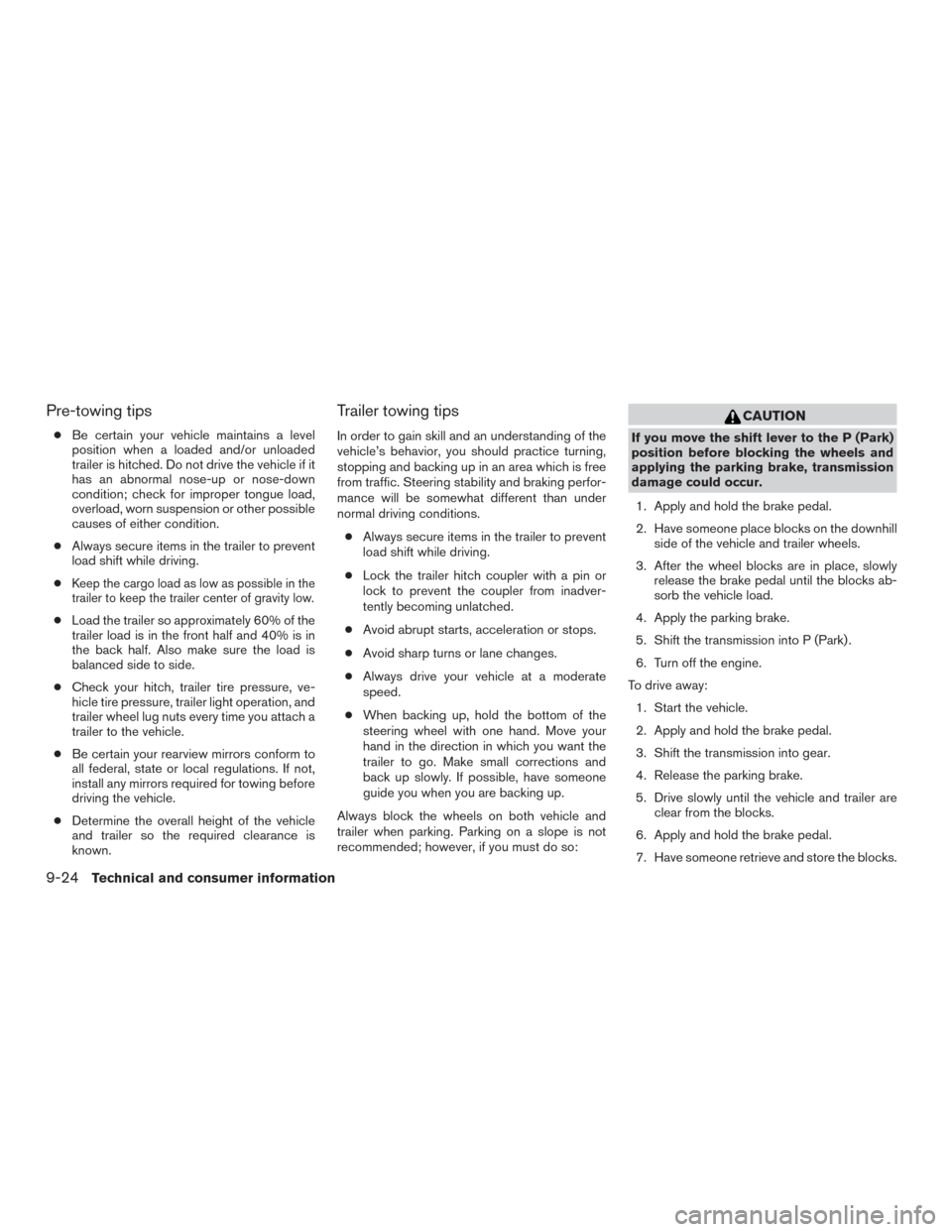
Pre-towing tips
●Be certain your vehicle maintains a level
position when a loaded and/or unloaded
trailer is hitched. Do not drive the vehicle if it
has an abnormal nose-up or nose-down
condition; check for improper tongue load,
overload, worn suspension or other possible
causes of either condition.
●Always secure items in the trailer to prevent
load shift while driving.
●
Keep the cargo load as low as possible in the
trailer to keep the trailer center of gravity low.
●Load the trailer so approximately 60% of the
trailer load is in the front half and 40% is in
the back half. Also make sure the load is
balanced side to side.
●Check your hitch, trailer tire pressure, ve-
hicle tire pressure, trailer light operation, and
trailer wheel lug nuts every time you attach a
trailer to the vehicle.
●Be certain your rearview mirrors conform to
all federal, state or local regulations. If not,
install any mirrors required for towing before
driving the vehicle.
●Determine the overall height of the vehicle
and trailer so the required clearance is
known.
Trailer towing tips
In order to gain skill and an understanding of the
vehicle’s behavior, you should practice turning,
stopping and backing up in an area which is free
from traffic. Steering stability and braking perfor-
mance will be somewhat different than under
normal driving conditions.
●Always secure items in the trailer to prevent
load shift while driving.
●Lock the trailer hitch coupler with a pin or
lock to prevent the coupler from inadver-
tently becoming unlatched.
●Avoid abrupt starts, acceleration or stops.
●Avoid sharp turns or lane changes.
●Always drive your vehicle at a moderate
speed.
●When backing up, hold the bottom of the
steering wheel with one hand. Move your
hand in the direction in which you want the
trailer to go. Make small corrections and
back up slowly. If possible, have someone
guide you when you are backing up.
Always block the wheels on both vehicle and
trailer when parking. Parking on a slope is not
recommended; however, if you must do so:
CAUTION
If you move the shift lever to the P (Park)
position before blocking the wheels and
applying the parking brake, transmission
damage could occur.
1. Apply and hold the brake pedal.
2. Have someone place blocks on the downhill
side of the vehicle and trailer wheels.
3. After the wheel blocks are in place, slowly
release the brake pedal until the blocks ab-
sorb the vehicle load.
4. Apply the parking brake.
5. Shift the transmission into P (Park) .
6. Turn off the engine.
To drive away:
1. Start the vehicle.
2. Apply and hold the brake pedal.
3. Shift the transmission into gear.
4. Release the parking brake.
5. Drive slowly until the vehicle and trailer are
clear from the blocks.
6. Apply and hold the brake pedal.
7. Have someone retrieve and store the blocks.
9-24Technical and consumer information
Page 443 of 465

Cargo(Seevehicleloadinginformation)....9-13
Car phone or CB radio.............4-51
CD care and cleaning..............4-48
CD player (See audio system).........4-41
Check tire pressure...............2-25
Child restraints.......1-25,1-25,1-27,1-29
LATCH (Lower Anchors and Tethers for
CHildren) System..............1-29
Precautions on child
restraints.........1-27,1-34,1-40,1-44
Top tether strap anchor point locations . .1-32
Child restraint with top tether strap.......1-31
Child safety rear door lock............3-7
Chimes, audible reminders...........2-15
Cleaningexteriorandinterior........7-2,7-4
Clock setting
(models without Navigation System)......4-39
C.M.V.S.S. certification label..........9-11
Cold weather driving...............5-88
Compact disc (CD) player...........4-41
Connect phone.................4-50
Consolebox...................2-45
Continuously Variable Transmission (CVT) . . .5-16
Continuously Variable Transmission (CVT)
fluid......................8-13
Driving with Continuously Variable
Transmission (CVT).............5-16
Controls
Heater and air conditioner controls.....4-27
Coolant
Capacities and recommended
fuel/lubricants.................9-2
Changing engine coolant...........8-9
Checking engine coolant level........8-9
Engine coolant temperature gauge.....2-6
Corrosionprotection ...............7-6Cruisecontrol..................5-39
Cupholders...................2-46
D
Daytime running light system (Canada only) . .2-34
Defroster switch
Rear window and outside mirror defroster
switch.....................2-32
Dimensionsandweights.............9-9
Dimmer switch for instrument panel......2-35
Door locks.....................3-5
Doors........................3-5
Drive belt.....................8-18
Drive positioner,
Automatic..........3-35,3-36,3-37,3-38
Driving
Cold weather driving.............5-88
Driving with Continuously Variable
Transmission (CVT).............5-16
Precautions when starting and
driving...................5-2,5-9
Driving the vehicle................5-16
E
Economy - fuel..................5-78
Emergency engine shutoff.........5-13,6-2
Emission control information label.......9-11
Emission control system warranty.......9-28
Engine
Before starting the engine..........5-14
Block heater.................5-89Capacities and recommended
fuel/lubricants.................9-2
Changing engine coolant...........8-9
Changingengineoil.............8-11
Changing engine oil filter..........8-12
Checking engine coolant level........8-9
Checking engine oil level..........8-10
Engine compartment check locations....8-7
Engine coolant temperature gauge.....2-6
Engine cooling system............8-8
Engineoil...................8-10
Engine oil and oil filter recommendation . . .9-6
Engine oil pressure warning light......2-10
Engine oil viscosity..............9-7
Engine serial number............9-11
Engine specifications.............9-8
Starting the engine.............5-15
Engine coolant temperature gauge.......2-6
Event Data recorders..............9-30
Exhaust gas (Carbon monoxide).........5-2
Explanation of maintenance items........8-2
Extended storage switch............2-42
F
Flashers (See hazard warning flasher switch) . .6-2
Flat tire.......................6-3
Floor mat positioning aid.............7-5
Fluid
Brake fluid..................8-14
Capacities and recommended
fuel/lubricants.................9-2
Continuously Variable Transmission (CVT)
fluid......................8-13
Enginecoolant.................8-8
10-2
Page 444 of 465
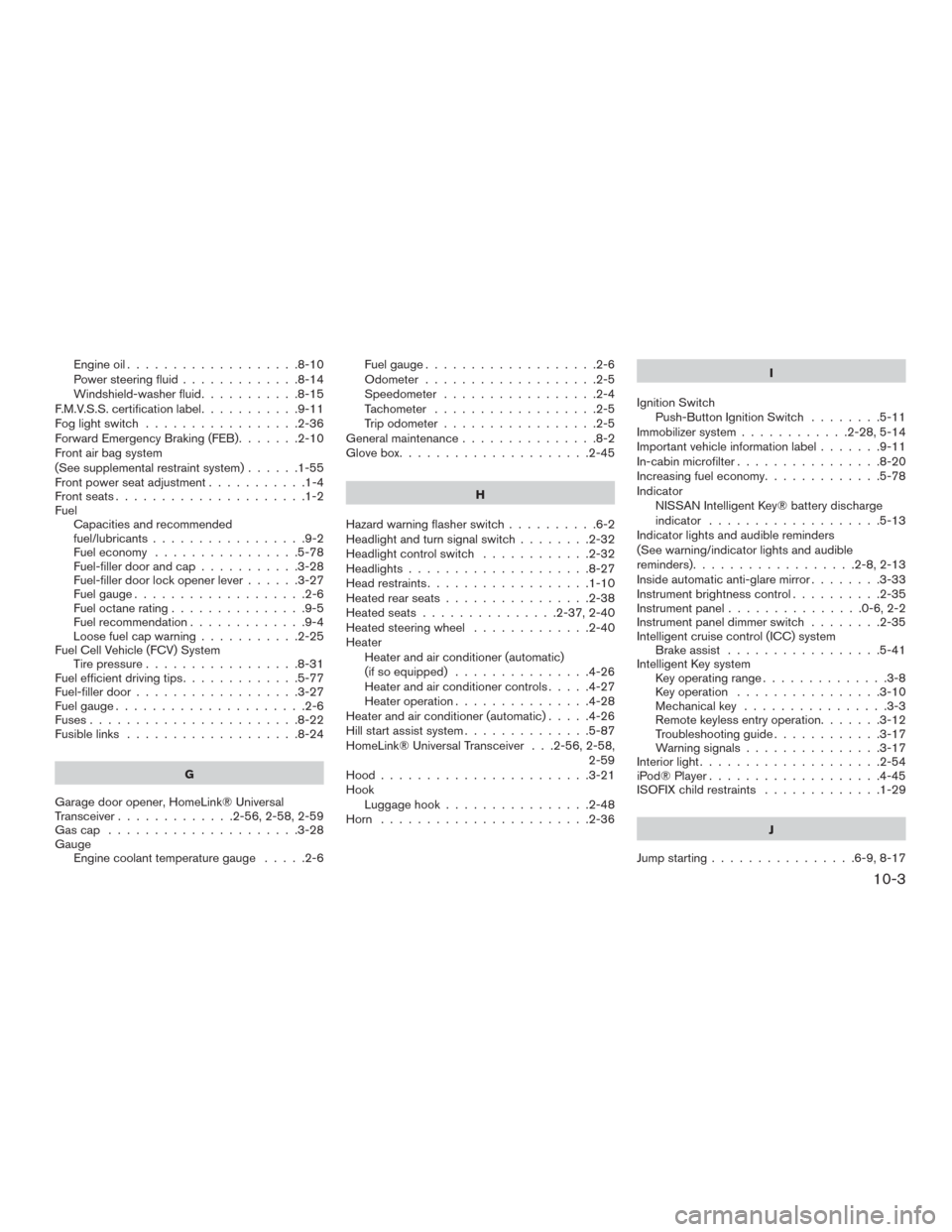
Engine oil...................8-10
Power steering fluid.............8-14
Windshield-washerfluid...........8-15
F.M.V.S.S. certification label...........9-11
Foglightswitch .................2-36
Forward Emergency Braking (FEB).......2-10
Front air bag system
(See supplemental restraint system)......1-55
Front power seat adjustment...........1-4
Frontseats.....................1-2
Fuel
Capacities and recommended
fuel/lubricants.................9-2
Fuel economy................5-78
Fuel-filler door and cap...........3-28
Fuel-filler door lock opener lever......3-27
Fuel gauge...................2-6
Fuel octane rating...............9-5
Fuel recommendation.............9-4
Loose fuel cap warning...........2-25
Fuel Cell Vehicle (FCV) System
Tirepressure.................8-31
Fuel efficient driving tips.............5-77
Fuel-filler door..................3-27
Fuel gauge.....................2-6
Fuses.......................8-22
Fusible links...................8-24
G
Garage door opener, HomeLink® Universal
Transceiver.............2-56,2-58,2-59
Gascap .....................3-28
Gauge
Engine coolant temperature gauge.....2-6Fuel gauge...................2-6
Odometer...................2-5
Speedometer.................2-4
Tachometer..................2-5
Trip odometer.................2-5
General maintenance...............8-2
Glovebox.....................2-45
H
Hazard warning flasher switch..........6-2
Headlight and turn signal switch........2-32
Headlight control switch............2-32
Headlights....................8-27
Head restraints..................1-10
Heated rear seats................2-38
Heated seats...............2-37,2-40
Heated steering wheel.............2-40
Heater
Heater and air conditioner (automatic)
(if so equipped)...............4-26
Heater and air conditioner controls.....4-27
Heater operation...............4-28
Heater and air conditioner (automatic).....4-26
Hill start assist system..............5-87
HomeLink® Universal Transceiver . . .2-56, 2-58,
2-59
Hood.......................3-21
Hook
Luggage hook................2-48
Horn .......................2-36I
Ignition Switch
Push-Button Ignition Switch........5-11
Immobilizer system............2-28,5-14
Important vehicle information label
.......9-11
In-cabin microfilter................8-20
Increasing fuel economy.............5-78
Indicator
NISSAN Intelligent Key® battery discharge
indicator ...................5-13
Indicator lights and audible reminders
(See warning/indicator lights and audible
reminders)..................2-8,2-13
Inside automatic anti-glare mirror........3-33
Instrument brightness control..........2-35
Instrumentpanel...............0-6,2-2
Instrument panel dimmer switch........2-35
Intelligent cruise control (ICC) system
Brake assist.................5-41
Intelligent Key system
Key operating range..............3-8
Key operation................3-10
Mechanical key................3-3
Remote keyless entry operation.......3-12
Troubleshooting guide............3-17
Warning signals...............3-17
Interior light....................2-54
iPod®Player...................4-45
ISOFIX child restraints.............1-29
J
Jump starting................6-9,8-17
10-3
Page 445 of 465
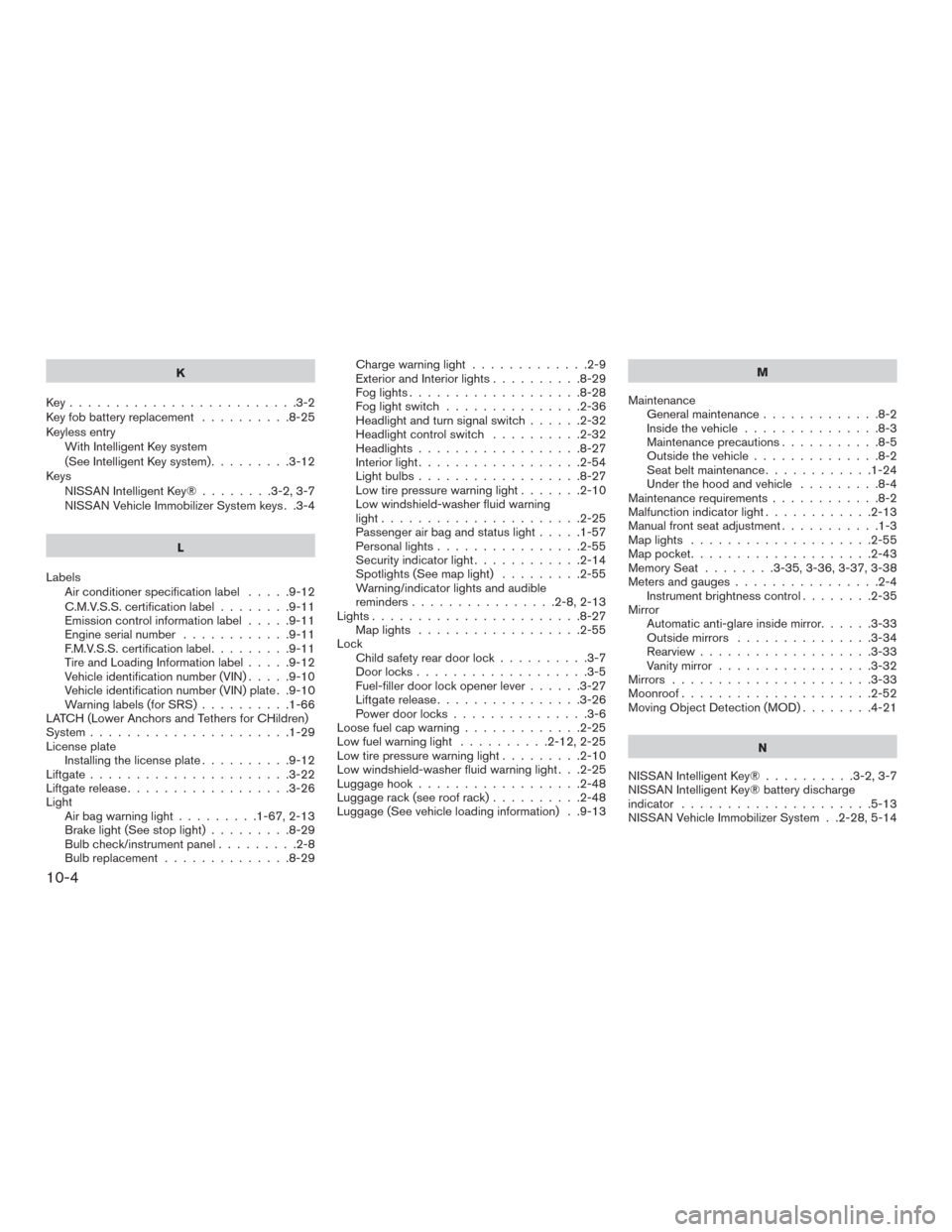
K
Key.........................3-2
Key fob battery replacement..........8-25
Keyless entry
With Intelligent Key system
(See Intelligent Key system).........3-12
Keys
NISSAN Intelligent Key®........3-2,3-7
NISSAN Vehicle Immobilizer System keys . .3-4
L
Labels
Air conditioner specification label.....9-12
C.M.V.S.S. certification label........9-11
Emissioncontrolinformationlabel.....9-11
Engine serial number............9-11
F.M.V.S.S. certification label.........9-11
Tire and Loading Information label.....9-12
Vehicle identification number (VIN).....9-10
Vehicle identification number (VIN) plate . .9-10
Warning labels (for SRS)..........1-66
LATCH (Lower Anchors and Tethers for CHildren)
System......................1-29
License plate
Installing the license plate..........9-12
Liftgate......................3-22
Liftgaterelease..................3-26
Light
Airbagwarninglight.........1-67,2-13
Brake light (See stop light).........8-29
Bulb check/instrument panel.........2-8
Bulb replacement..............8-29Charge warning light.............2-9
Exterior and Interior lights..........8-29
Foglights...................8-28
Foglightswitch ...............2-36
Headlight and turn signal switch......2-32
Headlight control switch..........2-32
Headlights..................8-27
Interiorlight..................2-54
Lightbulbs..................8-27
Low tire pressure warning light.......2-10
Low windshield-washer fluid warning
light......................2-25
Passenger air bag and status light.....1-57
Personal lights................2-55
Security indicator light............2-14
Spotlights(Seemaplight) .........2-55
Warning/indicator lights and audible
reminders................2-8,2-13
Lights.......................8-27
Maplights ..................2-55
Lock
Child safety rear door lock..........3-7
Door locks...................3-5
Fuel-filler door lock opener lever......3-27
Liftgate release................3-26
Power door locks...............3-6
Loose fuel cap warning.............2-25
Lowfuelwarninglight ..........2-12,2-25
Low tire pressure warning light.........2-10
Low windshield-washer fluid warning light . . .2-25
Luggage hook..................2-48
Luggage rack (see roof rack)..........2-48
Luggage (See vehicle loading information) . .9-13M
Maintenance
General maintenance.............8-2
Insidethevehicle...............8-3
Maintenance precautions...........8-5
Outside the vehicle..............8-2
Seat belt maintenance............1-24
Under the hood and vehicle.........8-4
Maintenance requirements............8-2
Malfunction indicator light............2-13
Manual front seat adjustment...........1-3
Maplights ....................2-55
Mappocket....................2-43
Memory Seat........3-35,3-36,3-37,3-38
Meters and gauges................2-4
Instrument brightness control........2-35
Mirror
Automatic anti-glare inside mirror......3-33
Outside mirrors...............3-34
Rearview...................3-33
Vanity mirror.................3-32
Mirrors......................3-33
Moonroof.....................2-52
Moving Object Detection (MOD)........4-21
N
NISSAN Intelligent Key®..........3-2,3-7
NISSAN Intelligent Key® battery discharge
indicator .....................5-13
NISSAN Vehicle Immobilizer System . .2-28, 5-14
10-4
Page 447 of 465
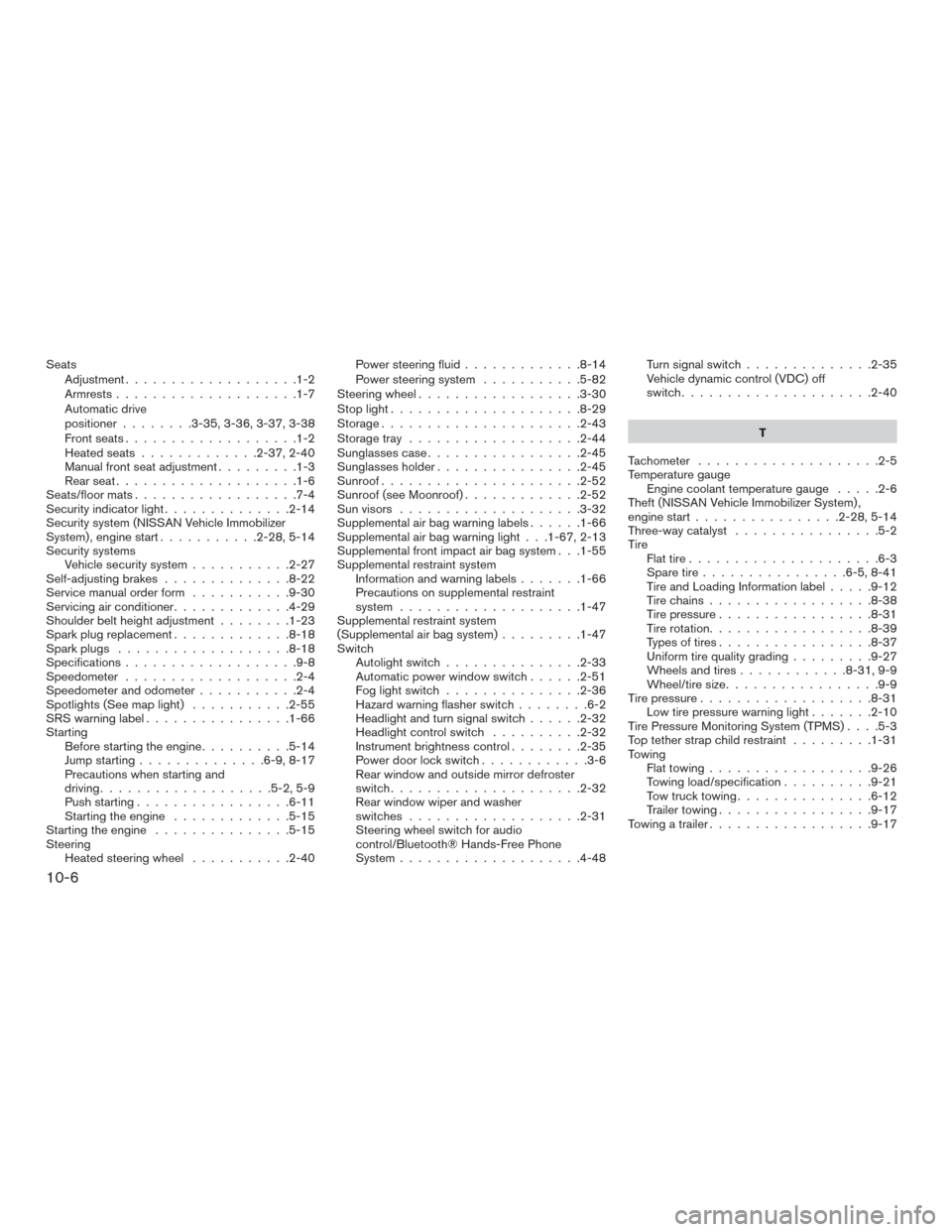
Seats
Adjustment...................1-2
Armrests....................1-7
Automatic drive
positioner........3-35,3-36,3-37,3-38
Frontseats...................1-2
Heatedseats.............2-37,2-40
Manual front seat adjustment.........1-3
Rear seat....................1-6
Seats/floor mats..................7-4
Security indicator light..............2-14
Security system (NISSAN Vehicle Immobilizer
System) , engine start...........2-28,5-14
Security systems
Vehicle security system...........2-27
Self-adjusting brakes..............8-22
Service manual order form...........9-30
Servicing air conditioner.............4-29
Shoulder belt height adjustment........1-23
Spark plug replacement.............8-18
Spark plugs...................8-18
Specifications...................9-8
Speedometer...................2-4
Speedometer and odometer...........2-4
Spotlights(Seemaplight) ...........2-55
SRS warning label................1-66
Starting
Before starting the engine..........5-14
Jump starting..............6-9,8-17
Precautions when starting and
driving...................5-2,5-9
Push starting.................6-11
Starting the engine.............5-15
Starting the engine...............5-15
Steering
Heated steering wheel...........2-40Power steering fluid.............8-14
Power steering system...........5-82
Steeringwheel..................3-30
Stoplight.....................8-29
Storage......................2-43
Storage tray...................2-44
Sunglassescase.................2-45
Sunglassesholder................2-45
Sunroof......................2-52
Sunroof(seeMoonroof).............2-52
Sun visors....................3-32
Supplemental air bag warning labels......1-66
Supplemental air bag warning light . . .1-67, 2-13
Supplemental front impact air bag system . . .1-55
Supplemental restraint system
Information and warning labels.......1-66
Precautions on supplemental restraint
system....................1-47
Supplemental restraint system
(Supplemental air bag system).........1-47
Switch
Autolightswitch...............2-33
Automatic power window switch......2-51
Foglightswitch ...............2-36
Hazard warning flasher switch........6-2
Headlight and turn signal switch......2-32
Headlight control switch..........2-32
Instrument brightness control........2-35
Power door lock switch............3-6
Rear window and outside mirror defroster
switch.....................2-32
Rear window wiper and washer
switches...................2-31
Steering wheel switch for audio
control/Bluetooth® Hands-Free Phone
System....................4-48Turnsignalswitch..............2-35
Vehicle dynamic control (VDC) off
switch.....................2-40
T
Tachometer....................2-5
Temperature gauge
Engine coolant temperature gauge.....2-6
Theft (NISSAN Vehicle Immobilizer System) ,
engine start................2-28,5-14
Three-way catalyst
................5-2
Tire
Flat tire.....................6-3
Spare tire................6-5,8-41
Tire and Loading Information label.....9-12
Tire chains..................8-38
Tire pressure.................8-31
Tire rotation..................8-39
Types of tires.................8-37
Uniform tire quality grading.........9-27
Wheels and tires............8-31,9-9
Wheel/tire size.................9-9
Tirepressure...................8-31
Low tire pressure warning light.......2-10
Tire Pressure Monitoring System (TPMS)....5-3
Top tether strap child restraint.........1-31
Towing
Flattowing..................9-26
Towing load/specification..........9-21
Towtrucktowing...............6-12
Trailer towing.................9-17
Towing a trailer..................9-17
10-6
Page 448 of 465
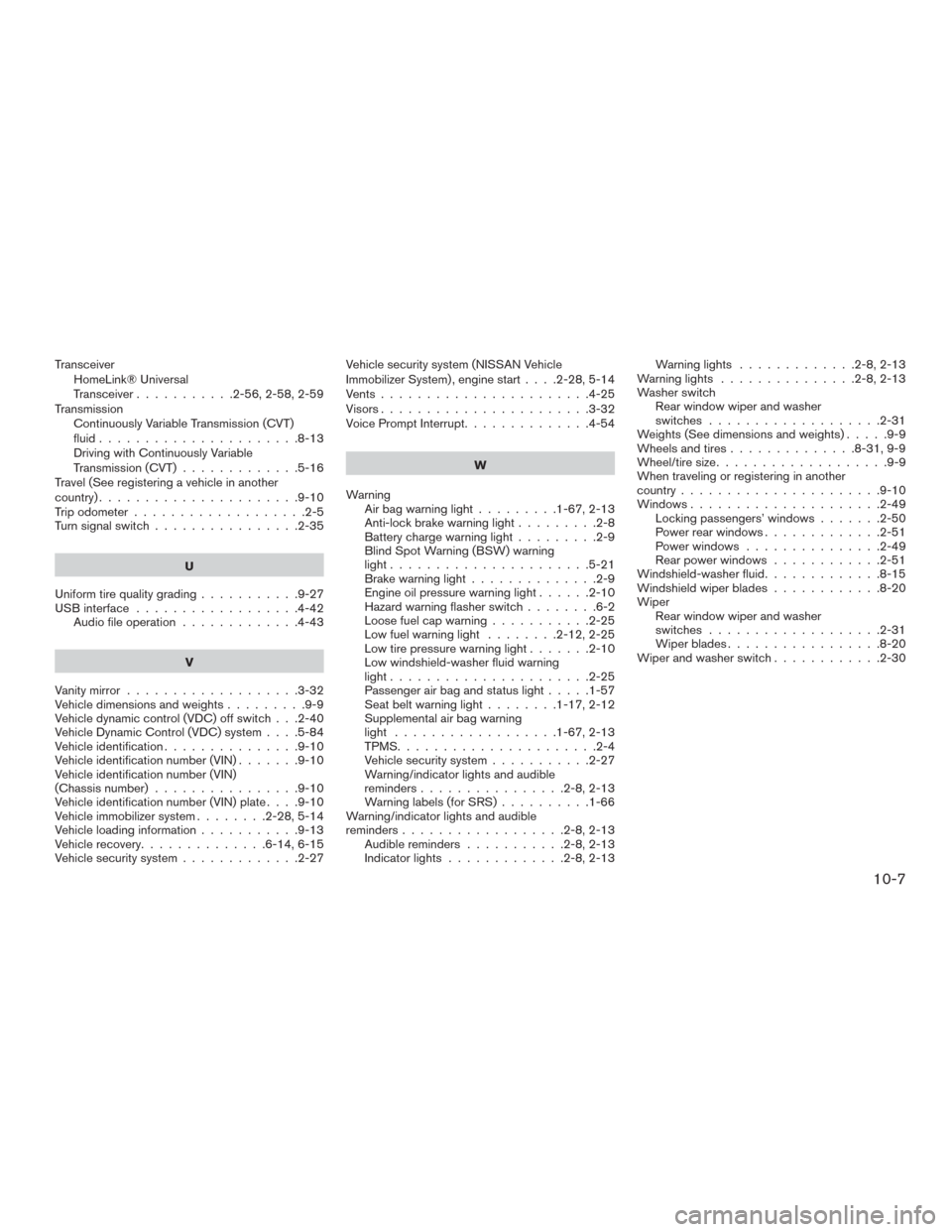
Transceiver
HomeLink® Universal
Transceiver...........2-56,2-58,2-59
Transmission
Continuously Variable Transmission (CVT)
fluid......................8-13
Driving with Continuously Variable
Transmission (CVT).............5-16
Travel (See registering a vehicle in another
country)......................9-10
Trip odometer...................2-5
Turn signal switch................2-35
U
Uniform tire quality grading...........9-27
USB interface..................4-42
Audio file operation.............4-43
V
Vanity mirror...................3-32
Vehicledimensionsandweights.........9-9
Vehicle dynamic control (VDC) off switch . . .2-40
Vehicle Dynamic Control (VDC) system....5-84
Vehicle identification...............9-10
Vehicle identification number (VIN).......9-10
Vehicle identification number (VIN)
(Chassis number)................9-10
Vehicle identification number (VIN) plate....9-10
Vehicle immobilizer system........2-28,5-14
Vehicleloadinginformation...........9-13
Vehicle recovery..............6-14,6-15
Vehicle security system.............2-27Vehicle security system (NISSAN Vehicle
Immobilizer System) , engine start....2-28,5-14
Vents.......................4-25
Visors.......................3-32
Voice Prompt Interrupt..............4-54
W
Warning
Airbagwarninglight.........1-67,2-13
Anti-lock brake warning light.........2-8
Battery charge warning light.........2-9
Blind Spot Warning (BSW) warning
light......................5-21
Brake warning light..............2-9
Engine oil pressure warning light......2-10
Hazard warning flasher switch........6-2
Loose fuel cap warning...........2-25
Lowfuelwarninglight ........2-12,2-25
Low tire pressure warning light.......2-10
Low windshield-washer fluid warning
light......................2-25
Passenger air bag and status light.....1-57
Seatbeltwarninglight........1-17,2-12
Supplemental air bag warning
light ..................1-67,2-13
TPMS......................2-4
Vehicle security system...........2-27
Warning/indicator lights and audible
reminders................2-8,2-13
Warning labels (for SRS)..........1-66
Warning/indicator lights and audible
reminders..................2-8,2-13
Audible reminders...........2-8,2-13
Indicatorlights.............2-8,2-13Warning lights.............2-8,2-13
Warning lights...............2-8,2-13
Washer switch
Rear window wiper and washer
switches...................2-31
Weights (See dimensions and weights).....9-9
Wheels and tires..............8-31,9-9
Wheel/tire size...................9-9
When traveling or registering in another
country......................9-10
Windows.....................2-49
Locking passengers’ windows.......2-50
Power rear windows.............2-51
Power windows...............2-49
Rear power windows............2-51
Windshield-washerfluid.............8-15
Windshieldwiperblades............8-20
Wiper
Rear window wiper and washer
switches...................2-31
Wiperblades.................8-20
Wiper and washer switch............2-30
10-7
Page 449 of 465
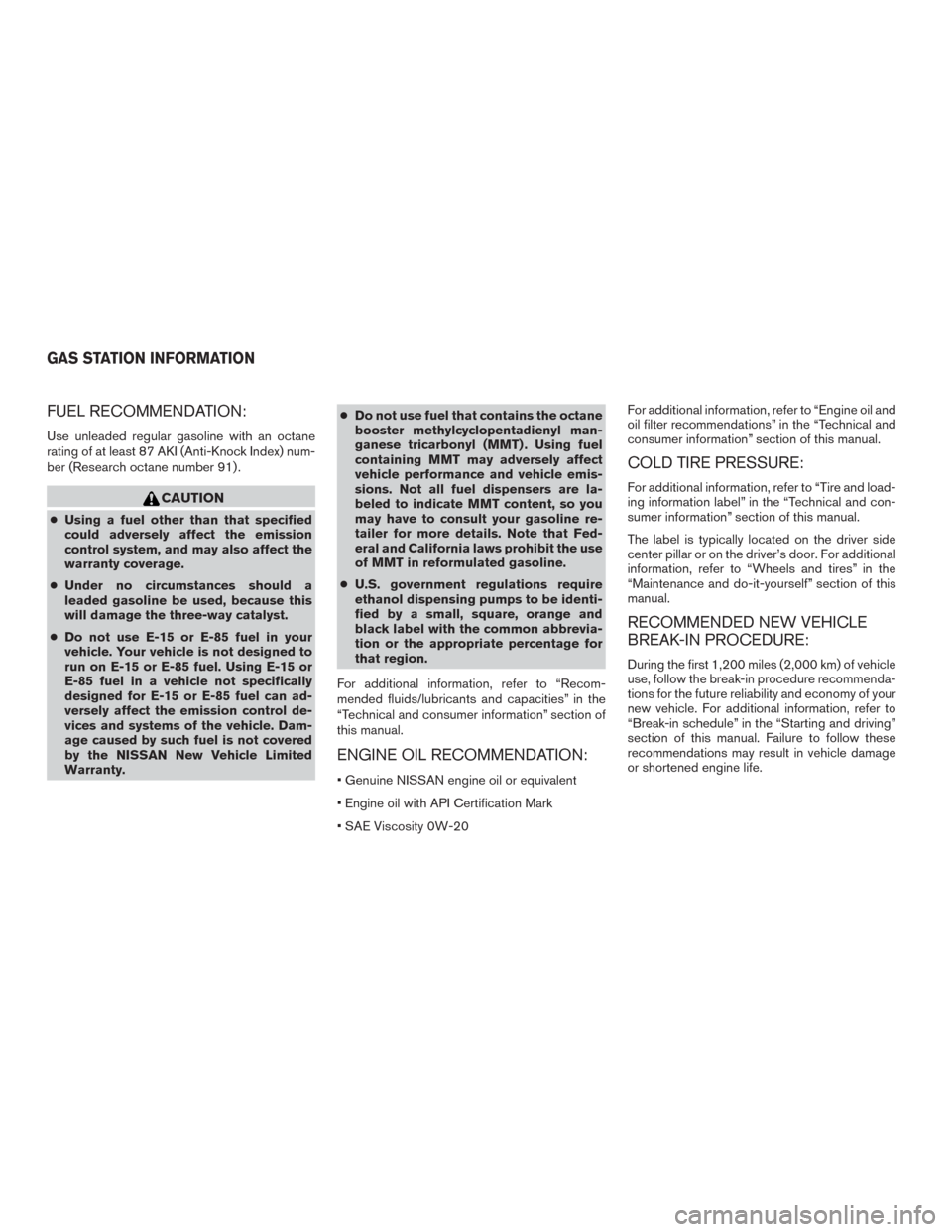
FUEL RECOMMENDATION:
Use unleaded regular gasoline with an octane
rating of at least 87 AKI (Anti-Knock Index) num-
ber (Research octane number 91) .
CAUTION
●Using a fuel other than that specified
could adversely affect the emission
control system, and may also affect the
warranty coverage.
●Under no circumstances should a
leaded gasoline be used, because this
will damage the three-way catalyst.
●Do not use E-15 or E-85 fuel in your
vehicle. Your vehicle is not designed to
run on E-15 or E-85 fuel. Using E-15 or
E-85 fuel in a vehicle not specifically
designed for E-15 or E-85 fuel can ad-
versely affect the emission control de-
vices and systems of the vehicle. Dam-
age caused by such fuel is not covered
by the NISSAN New Vehicle Limited
Warranty.●Do not use fuel that contains the octane
booster methylcyclopentadienyl man-
ganese tricarbonyl (MMT) . Using fuel
containing MMT may adversely affect
vehicle performance and vehicle emis-
sions. Not all fuel dispensers are la-
beled to indicate MMT content, so you
may have to consult your gasoline re-
tailer for more details. Note that Fed-
eral and California laws prohibit the use
of MMT in reformulated gasoline.
●U.S. government regulations require
ethanol dispensing pumps to be identi-
fied by a small, square, orange and
black label with the common abbrevia-
tion or the appropriate percentage for
that region.
For additional information, refer to “Recom-
mended fluids/lubricants and capacities” in the
“Technical and consumer information” section of
this manual.
ENGINE OIL RECOMMENDATION:
• Genuine NISSAN engine oil or equivalent
• Engine oil with API Certification Mark
• SAE Viscosity 0W-20For additional information, refer to “Engine oil and
oil filter recommendations” in the “Technical and
consumer information” section of this manual.
COLD TIRE PRESSURE:
For additional information, refer to “Tire and load-
ing information label” in the “Technical and con-
sumer information” section of this manual.
The label is typically located on the driver side
center pillar or on the driver’s door. For additional
information, refer to “Wheels and tires” in the
“Maintenance and do-it-yourself” section of this
manual.
RECOMMENDED NEW VEHICLE
BREAK-IN PROCEDURE:
During the first 1,200 miles (2,000 km) of vehicle
use, follow the break-in procedure recommenda-
tions for the future reliability and economy of your
new vehicle. For additional information, refer to
“Break-in schedule” in the “Starting and driving”
section of this manual. Failure to follow these
recommendations may result in vehicle damage
or shortened engine life.
GAS STATION INFORMATION